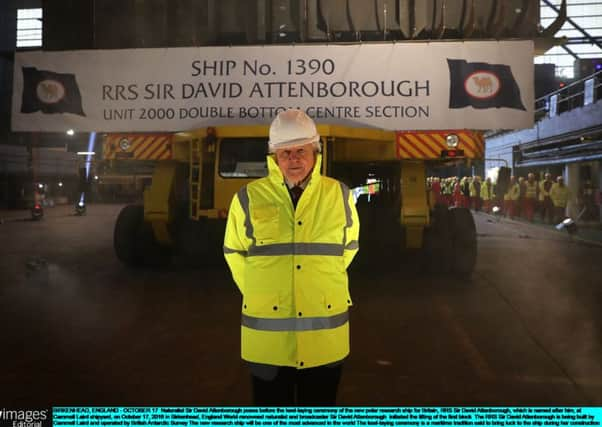Sir David presses start button on '˜Boaty McBoatface'


The 90-year-old naturalist and TV presenter pressed a green button which began the keel-laying ceremony, watched by hundreds of shipbuilders in hard hats at Cammell Laird’s cavernous construction hall on the banks of the River Mersey at Birkenhead.
It set in train the movement of a huge crane lifting a 53-tonne section of the ship into place on a slipway, around which the rest of the vessel will be built in separate sections.
Advertisement
Hide AdAdvertisement
Hide AdIt will officially be named the RRS (Royal Research Ship) Sir David Attenborough, but will forever be nicknamed Boaty McBoatface “until she sinks or is decommissioned” as one shipbuilder at Monday’s ceremony said.
In a “name our ship” competition, Boaty McBoatface topped the public poll with more than 124,000 votes - more than three times its nearest rival - but that name was vetoed.
However, Boaty will live on, in the form of a miniature, unmanned, yellow submarine on board the vessel.
Monday’s traditional maritime ceremony, which took place amid much fanfare, is said to bring good luck to a ship.
The £200 million, 15,000-tonne research vessel, likened to a huge floating laboratory, is the most technically advanced survey ship ever built, and will have a crew of 30 and accommodate 60 scientists when finished.
It has been commissioned by the Natural Environment Research Council (NERC) and is being built on Merseyside in the largest commercial shipbuilding project in the UK in 30 years.
After sea trials in 2018, it will launch the following year and work in temperatures of minus 30C (minus 22F) in the most inhospitable places on Earth.
Sir David, whose TV series Frozen Planet showed life at the polar extremes, said the naming of the vessel in his honour gave him “deep pleasure”.
Advertisement
Hide AdAdvertisement
Hide AdHe said: “I have had several opportunities to experience the power of these places first hand.
“This new ship will ensure that scientists have access to these enigmatic regions to uncover secrets that we can only imagine at this point.
“Scientists working on this new ship will inform everyone about our changing world for generations to come.”